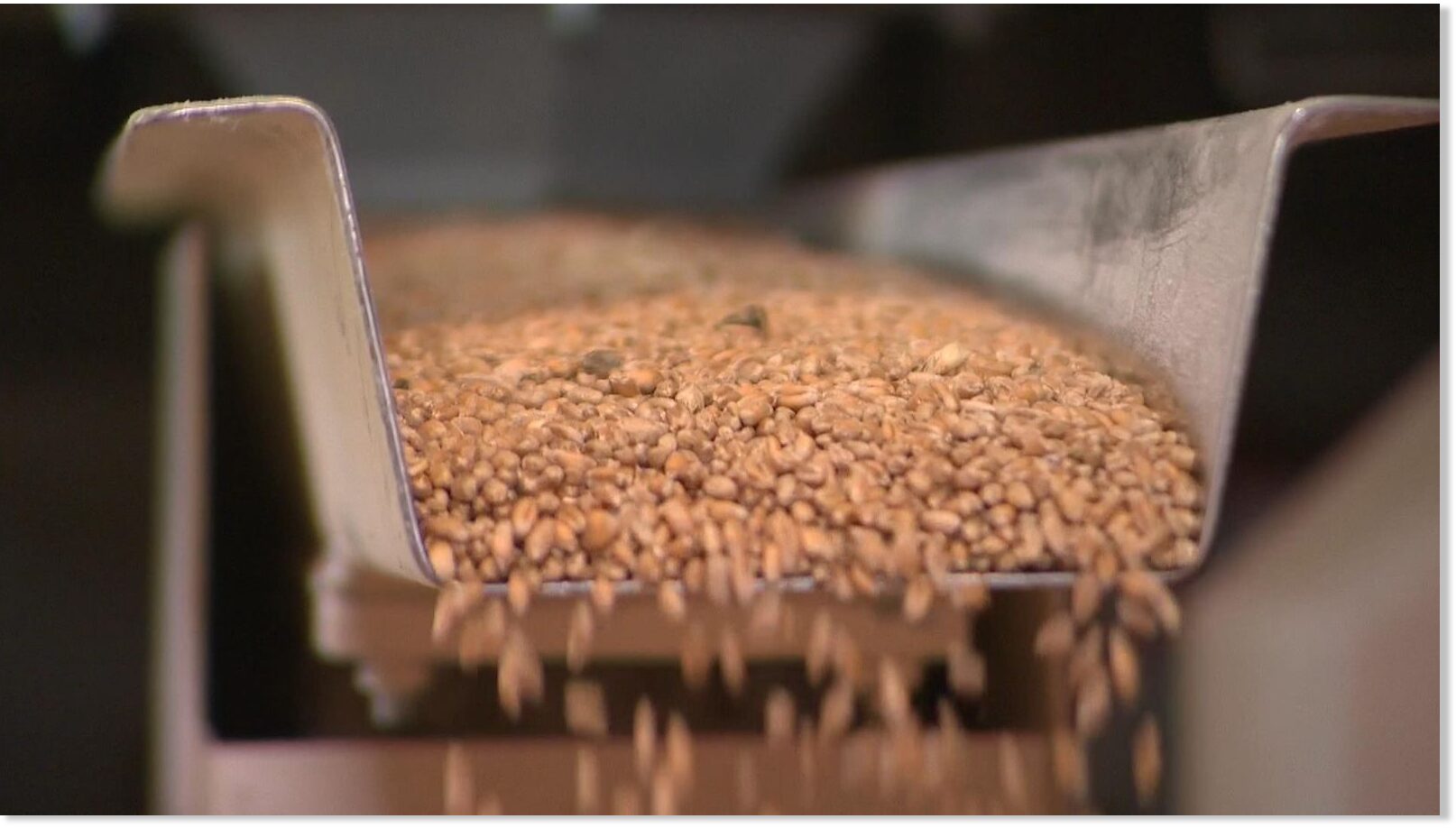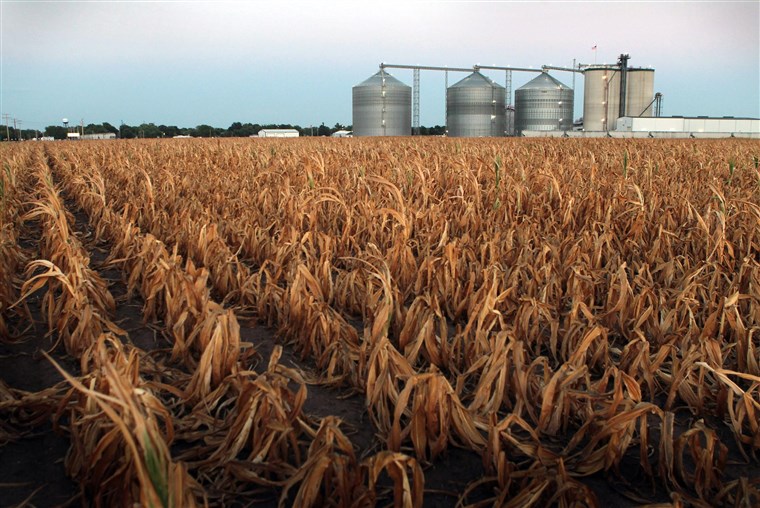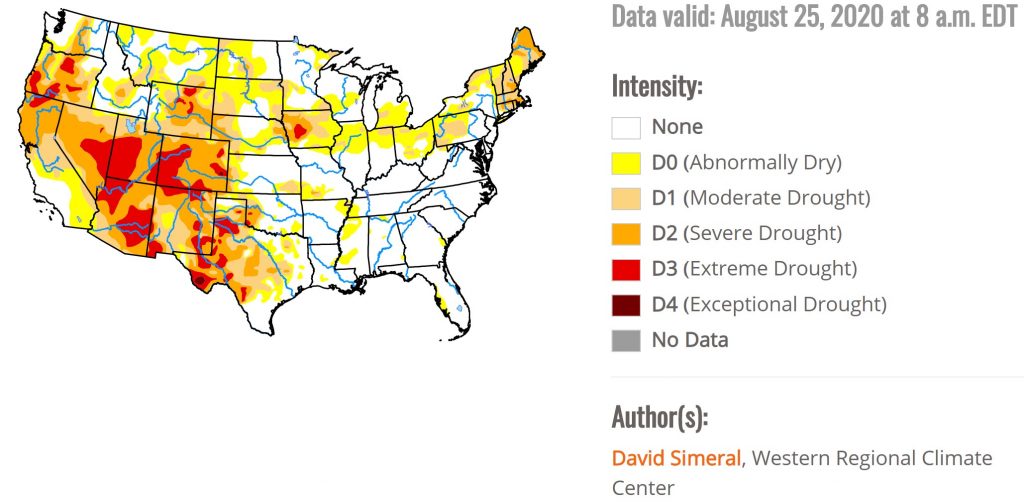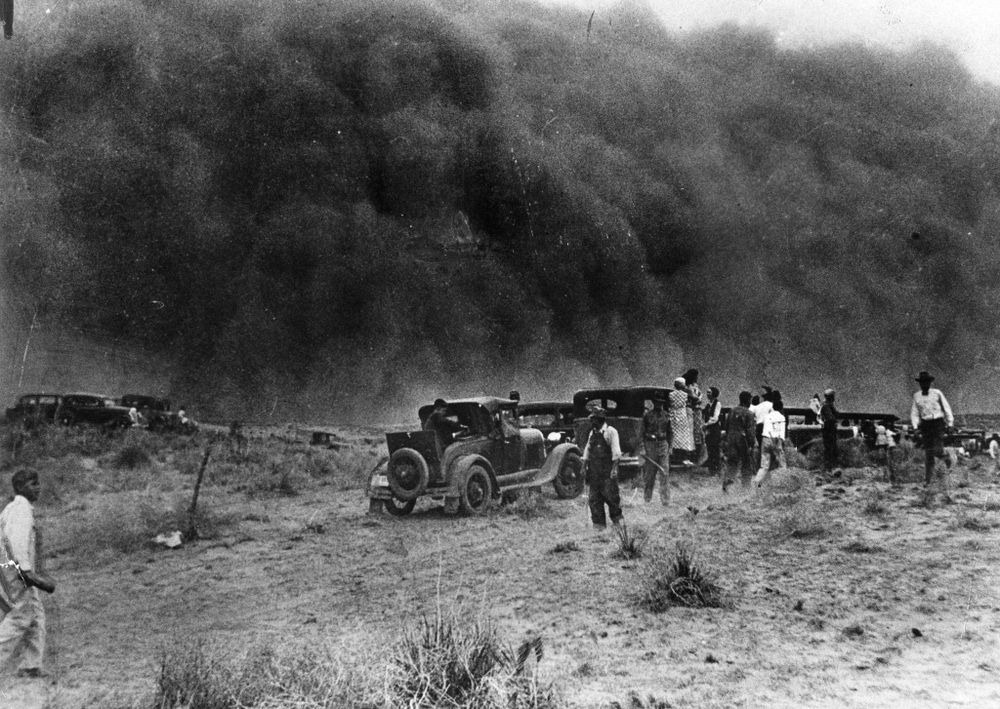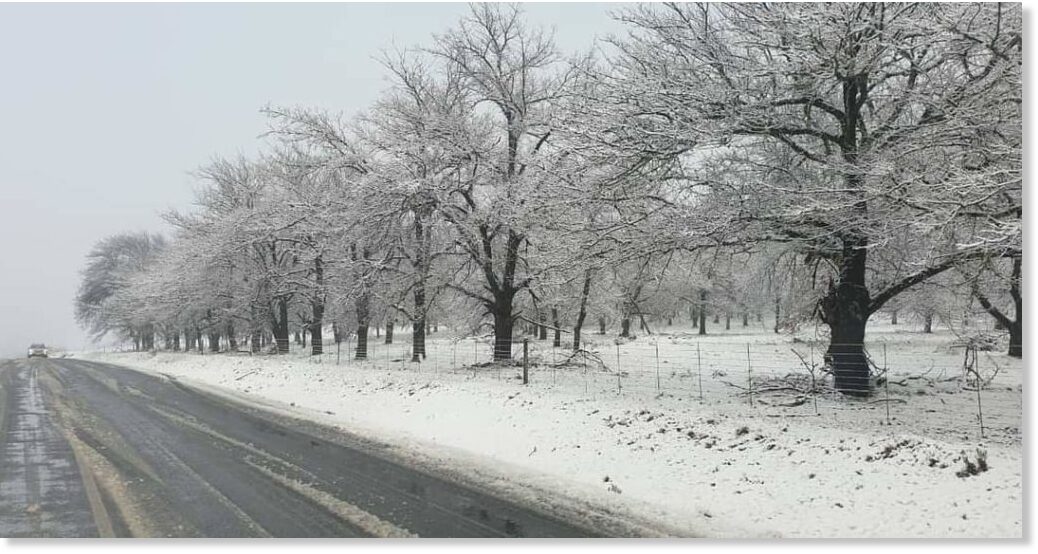Iowa's farmers are facing a double blast: First the derecho on August 10, 2020 and now an extreme drought in more than 96% of the state.

strangesounds.org
Iowa’s farmers double blast: First the derecho, now a dramatic drought
By
Strange Sounds - Aug 28, 2020
A derecho’s hurricane-force winds slammed through about half of Chad West’s 4,500 acres of corn and soybeans Aug. 10.
Now, the drought is burning up the rest of his crop, the central Iowa farmer said.
The latest US Drought Monitor released Thursday morning showed drought has expanded across 96 percent of Iowa. It’s the largest drought coverage area in the state since September of 2013. Picture: Scott Olson / Getty Images file
West, 49, spent part of this week
disking under 300 acres of corn that’s considered a complete loss.
“
You put so much time, money and effort into a crop, to give up and say, ‘We’re not going to harvest this’ … it’s really disheartening,” he said, adding that he anticipates he will need to
disk under another 400 flattened acres of corn, too.
The ever-widening drought now encompasses
three-fifths of Iowa, the U.S. Drought Monitor’s latest map showed Thursday. Nearly all of the rest of the state is considered abnormally dry, with only a few pockets of Iowa escaping both the drought and derecho.
Extreme drought after derecho in Iowa. Map:
Drought Monitor
Drought details
More than 60% of Iowa is now in some form of drought, the U.S. Department of Agriculture said Thursday.
Parts of 34 Iowa counties are now in severe drought, up from 29 one week ago, according to the USDA. Thirteen west-central Iowa counties remain in extreme drought, a figure unchanged over the past three weeks.
Overall, 60.88% of Iowa is in some type of drought. Almost 97% of Iowa is listed as abnormally dry.
View: https://twitter.com/25Barnett/status/1299301828136402944
The National Weather Service in Des Moines published new data this week that revealed the toll the drought is taking on west-central Iowa. Through Aug. 20, Carroll County received 11 inches less rain than normal and 12.52 inches less rain than normal, according to the NWS.
Guthrie Center and Audubon received about 13 inches and 11 inches less rain than normal, according to the NWS.
The drought is spreading farther north. Storm Lake received 5 inches less rain than normal, according to the NWS in Sioux Falls.
View: https://twitter.com/NWSDesMoines/status/1298103785093357569
Over the past week, Iowa saw temperatures soar to nearly 100 degrees, baking corn and soybean fields, many already damaged by the storm. Some rain-starved Iowa cities — such as Carroll and Audubon — have recorded about
a foot less annual precipitation than average.
Justin Glisan, the state climatologist, said Thursday that
the growing drought in Iowa is the most severe since one that spanned 151 weeks from 2011-14.
This year’s drought will most likely push farmers into fields by mid-September, about two weeks earlier than normal, to combine corn and soybeans that the adverse weather is driving to maturity faster, though with lower yields.
Lower temperatures and a chance of rain are forecast in the days ahead,
but any precipitation is likely to be too late to provide much help.
The drought has the Des Moines Water Works concerned about
high toxin levels from blue-green algae in the Des Moines River. The utility said it’s unable to tap the river for drinking water because of high microcystin levels.
The agency primarily relies on the Raccoon River for drinking water for 500,000 central Iowa residents, though it also draws from the Des Moines.
“
It’s really a source of last resort,” said Des Moines Water Works CEO Ted Corrigan, who’s also closely monitoring declining water levels in the Raccoon.
The microcystin levels in the Des Moines River in recent days were
eight to 11 times higher than the federal recommendation for water consumed by toddlers and infants. Toxic blue-green algae likes the warm, stagnant water that droughts generate, most likely centering in the river’s Saylorville reservoir.
“
We don’t have a treatment process that targets removal of microcystins generated within the algae,” Corrigan said. “
Our best bet is just to avoid it.“
The utility is considering drilling wells in the alluvial aquifer along the Des Moines River that would eliminate its exposure to blue-green algae, Corrigan said.
He added that the well water also tends to be lower in nitrates and other pollutants.
But the new alluvial wells “
would cost tens of millions of dollars” and would be likely to push consumer bills higher, he said.
“
This week, we’re at the intersection of poor water quality, high demand and drought,” said Corrigan, though he said the utility does not plan to impose limits on water usage. It would first ask consumers to curb watering lawns, which absorbs as much of 40% of the supply.
Agriculture Secretary Mike Naig said that if there’s any good news in the latest Drought Monitor report, “
it’s that the extreme drought hasn’t grown.” It remains centered on 11 counties in west-central Iowa.
View: https://twitter.com/NASAHarvest/status/1298673814629490689
Larry Buss, who farms in western Iowa near Logan, said crops there would be drying up without widespread irrigation in the Missouri River valley.
In small pockets where irrigation hasn’t reached soybeans, “they’re dead,” said Buss, who farms with his family. “Our crop is going to be shortened up.“
Glisan, the state climatologist, said the
Midwest has seen droughts become more frequent and intense over the past 30 years. A drought in 1988 and the one that peaked in 2012 were expansive, he said.
A 2018 drought caused by a high-pressure ridge camped over most of Missouri also hit southern Iowa. Even last year — when many western Iowa farmers were dealing with flooding — eastern and central Iowa were in moderate droughts, Glisan said.
“
So if you look at the time series going back to 2000, we have seen a pretty substantial portion of that in drought,” Glisan said.
Some farmers have told Mark Licht, an Iowa State University crop specialist,
they could begin harvesting drought-hit fields as early as Labor Day weekend.
A farm near Licht’s central Iowa home was green on Sunday but had turned mostly yellow by Wednesday. Some plants were brown and losing their leaves, the natural process crops follow before being harvested.
And, the Western U.S. is facing the
worst megadrought in over 1,200 years, say a recent study:
Megadrought emerging in western U.S. could be the worst in 1,200 shows a new scientific study published in Journal Science. Another one bites the dust?

strangesounds.org
West, the central Iowa farmer who was disking under corn this week, said
his crop insurance will help him with damaged and destroyed crops, hit both by the drought and the derecho. “I’ll be all right financially,” he said Wednesday.
He’s had to buy a special piece of equipment — a $12,000 corn reel — that will help him harvest corn that’s lying down because of the derecho winds.
Still, disking under a corn crop shakes him. “
This isn’t what farmers do. It feels like a failure if you’re not combining a crop,” said West, coming from a field that his family has farmed for 100 years.
It was shaping up to be a good crop before the storm hit.
“
We’ve never done this before,” West said. “
It doesn’t seem right.“
And be prepared to bite the dust once again, because scientists think the Dust Bowl is coming back for a second round.
And this time for it could even last during decades.
Another Dust Bowl Storm will devastate the western United States during several decades again and nobody is prepared for it.

strangesounds.org
So do you think we are heading to a new megadrought in the U.S.? Well this new threat on soy and corn harvests could have dramatic consequences on food prices and industry in North America. Be ready!









